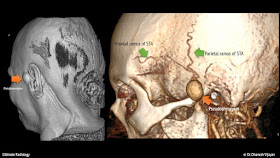The anterior branch of the STA is most vulnerable to injury from blunt trauma due to its superficial course and close proximity to the underlying bony structures.
The time period from craniotomy to pseudoaneurysm in the literature varied between 4 days and 3 months. Differential diagnoses for STA pseudoaneurysm include vascular tumor, arteriovenous fistula, meningeal artery aneurysm with bony erosion, subcutaneous lipoma, abscess, and localized hematoma.
The following is a case of left Superficial Temporal Artery pseudoaneurysm in a 69yr old female, arising after a trauma to the side of the head, hitting an open window, 2 years back, with transient loss of consciousness. Swelling was slowly increasing in size.
The ultrasound image below shows a clear defect in the STA vessel wall of ~6.8mm length, with the pseudoaneurysm measuring ~16mm x 11mm.
The ultrasound image below shows a clear defect in the STA vessel wall of ~6.8mm length, with the pseudoaneurysm measuring ~16mm x 11mm.
References:
Superficial Temporal Artery Pseudoaneurysm: A Case Report
Syed Muneeb Younus, Muhammad Imran, Rabia Qazi
Front Surg. 2015; 2: 51. Published online 2015 Oct 6. doi: 10.3389/fsurg.2015.00051
PMCID: PMC4593946
Primary repair of a traumatic superficial temporal artery pseudoaneurysm: case report and literature review. Ayling O, Martin A, Roche-Nagle G, Vasc Endovascular Surg. 2014 May; 48(4):346-8.
Ruptured pseudoaneurysm of the superficial temporal artery after craniotomy.
Honda M, Anda T, Ishihara T, Neurol India. 2013 Nov-Dec; 61(6):698-9.
http://www.ajnr.org/content/cow/10252010








No comments:
Post a Comment